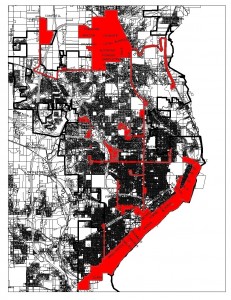Back in May, Peoria’s Economic Development director Craig Hullinger asked District 150 to be a part of the Enterprise Zone for the Main Street Commons project, and I wrote this post in response. Craig, who is a really nice guy and very communicative, wrote me and we had an interesting e-mail exchange. He asked me if he could post it on his blog (did I mention he’s very communicative?), and I said that was fine with me, so here it is. I’m not sure why his post is dated September of 2008 because we didn’t have our discussion until just the last couple of months. Perhaps he just updated an old post.
Anyway, I was rereading it today, and now I have some more questions. For example, Craig says:
Any development is risky. The safest developments are on undeveloped land (green grass sites). It is easier to buy a large tract of land. Less likely to have costly environmental problems hidden underground. Urban redevelopment is always more difficult. It is harder to assemble the land – usually multiple owners. Older areas have more poverty and crime.
I think you can see that this is true by comparing the level of development in the suburban areas of Peoria versus the older areas. More development takes place in new areas. It is always a struggle to get investment in older areas. We try to equalize the difference between new and old with incentives.
Now look at this map of the current Enterprise Zone:
Notice the big red area up in the far north part of town? Up there where there are green grass sites? Where it is easier to buy a large tract of land? Where it is less likely to have costly environmental problems hidden underground? Up where they, in short, need no incentives?
Why is the Enterprise Zone up there?
And furthermore, doesn’t that just step all over the theory of “equaliz[ing] the difference between new and old with incentives”? If a developer can get the same incentives up where there’s a green field, doesn’t that kind of “equalization” work against redeveloping the older parts of town?
One more question, for the record. Craig said:
There is a good market. We hired the premier market research firm, Tracy Cross, to assess the market for new close into downtown housing. They said the market was strong, for creative class young professionals, but that renters lead the urban renaissance, and that the rents had to be about $1.00 a square foot. It is hard to build a quality brick building that will rent for that rate without incentives.
So, we can expect this development to be a “quality brick building” now that these incentives are in place? And that rents will be competitive? So noted. I’ll be referring back to this post when the construction materials are made public. When I asked at the public meeting what materials would be used, I was told they hadn’t decided yet.


Until May, there was never any mention that this development would pursue any kind of government hand-out program. Early on, it had been comunicated that it would be 100% privately funded. Guess that changed.
“Guess that changed.” You are surprised? If the government is going to hand out ‘free’ money… why not try for it? Look if a hotel and a museum can get millions surely a dime could be spared for some Main Street redevelopment.